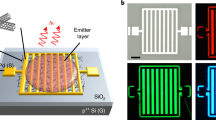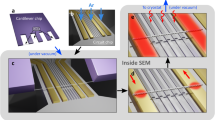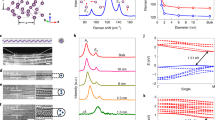Abstract
The positioning of single molecules between nanoscale electrodes1,2,3,4,5,6,7,8 has allowed their use as functional units in electronic devices. Although the electrical transport in such devices has been widely explored, optical measurements have been restricted to the observation of electroluminescence from nanocrystals and nanoclusters9,10 and from molecules in a scanning tunnelling microscope setup11,12. In this Letter, we report the observation of electroluminescence from the core of a rod-like molecule between two metallic single-walled carbon nanotube electrodes forming a rigid solid-state device. We also develop a simple model to explain the onset voltage for electroluminescence. These results suggest new characterization and functional possibilities, and demonstrate the potential of carbon nanotubes for use in molecular electronics.
This is a preview of subscription content, access via your institution
Access options
Subscribe to this journal
Receive 12 print issues and online access
$259.00 per year
only $21.58 per issue
Buy this article
- Purchase on Springer Link
- Instant access to full article PDF
Prices may be subject to local taxes which are calculated during checkout



Similar content being viewed by others
References
Reed, M. A., Zhou, C., Muller, C. J., Burgin, T. P. & Tour, J. M. Conductance of a molecular junction. Science 278, 252–254 (1997).
Datta, S. et al. Current–voltage characteristics of self-assembled monolayers by scanning tunneling microscopy. Phys. Rev. Lett. 79, 2530–2533 (1997).
Reichert, J. et al. Driving current through single organic molecules. Phys. Rev. Lett. 88, 176804 (2002).
de Picciotto, A. et al. Prevalence of Coulomb blockade in electro-migrated junctions with conjugated and non-conjugated molecules. Nanotechnology 16, 3110–3114 (2005).
Song, H. et al. Observation of molecular orbital gating. Nature 462, 1039–1043 (2009).
Qi, P. et al. Miniature organic transistors with carbon nanotubes as quasi one-dimensional electrodes. J. Am. Chem. Soc. 126, 11774–11775 (2004).
Guo, X. et al. Covalently bridging gaps in single-walled carbon nanotubes with conducting molecules. Science 311, 356–359 (2006).
Feldmann, A. K., Steigerwald, M. L., Guo, X. & Nuckolls, C. Molecular electronic devices based on single-walled carbon nanotube electrodes. Acc. Chem. Res. 41, 1731–1741 (2008).
Gonzalez, J. I., Lee, T.-H., Barnes, M. D., Antoku, Y. & Dickson, R. M. Quantum mechanical single-gold-nanocluster electroluminescent light source at room temperature. Phys. Rev. Lett. 93, 147402 (2004).
Gudiksen, M. S., Maher, K. N., Ouyang, L. & Park, H. Electroluminesence from a single-nanocrystal transistor. Nano Lett. 5, 2257–2261 (2005).
Qiu, X. H., Nazin, G. V. & Ho, W. Vibrationally resolved fluorescence excited with submolecular precision. Science 299, 542–546 (2003).
Dong, Z. et al. Vibrationally resolved fluorescence from organic molecules near metal surfaces in a scanning tunneling microscope. Phys. Rev. Lett. 92, 086801 (2004).
Buker, J. & Kirczenow, G. Theoretical study of photon emission from molecular wires. Phys. Rev. B 66, 2453061 (2002).
Grunder, S. et al. Synthesis and optical properties of molecular rods comprising a central core-substituted naphthalenediimide chromophore for carbon nanotube junctions. Eur. J. Org. Chem. doi: 10.1002/ejoc.201001415 (accepted).
Błaszczyk, A., Fischer, M., von Hänisch, C. & Mayor, M. Synthesis, structure, and optical properties of terminally sulfur-functionalized core-substituted naphthalene–bisimide dyes. Helv. Chim. Acta 89, 1986–2005 (2006).
Jin, C., Suenaga, K. & Iijima, S. Plumbing carbon nanotubes. Nature Nanotech. 3, 17–21 (2008).
Essig, S. et al. Phonon-assisted electroluminescence from metallic carbon nanotubes and graphene. Nano Lett. 10, 1589–1594 (2010).
Lamouche, G., Lavallard, P. & Gacoin, T. Optical properties of dye molecules as a function of the surrounding dielectric medium, Phys. Rev. A 59, 4668–4674 (1999).
Valeur, B., Molecular Fluorescence 113–124 (Wiley-VCH, 2001).
Sakai, N., Mareda, J., Vauthey, E. & Matile, S. Core-substituted naphthalenediimides. Chem. Commun. 46, 4225–4237 (2010).
Sonogashira, K. Metal-Catalyzed Cross-Coupling Reactions 203–229 (Wiley-VCH, 1998).
Vijayaraghavan, A. et al. Ultra-large-scale directed assembly of single-walled carbon nanotube devices. Nano Lett. 7, 1556–1560 (2007).
Lebedkin, S. et al. Single-walled carbon nanotubes with diameters approaching 6 nm obtained by laser vaporization. Carbon 40, 417–423.
Moshammer, K., Hennrich, F. & Kappes, M. M. Selective suspension in aqueous sodium dodecyl sulfate according to electronic structure type allows simple separation of metallic from semiconducting single-walled carbon nanotubes. Nano Res. 2, 599–606 (2009).
Hersam, M. C. Progress towards monodisperse single-walled carbon nanotubes. Nature Nanotech. 3, 387–394 (2008).
Marquardt, C. W. Reversible metal–insulator transitions in metallic single-walled carbon nanotubes. Nano Lett. 8, 2767–2772 (2008).
Collins, P. G., Hersam, M., Arnold, M., Martel, R. & Avouris, P. Current saturation and electrical breakdown in multiwalled carbon nanotubes. Phys. Rev. Lett. 86, 3128–3131 (2001).
Acknowledgements
The authors acknowledge helpful discussions with E. Dormann, M. Hettler and F. Evers, technical support by M. Fischer, and the help of C. Grupe with the graphics of the NT–M–NT junction. The ongoing support of the Karlsruhe Institute of Technology and of the University of Basel is gratefully acknowledged. The research was funded by the Initiative and Networking Fund of the Helmholtz-Gemeinschaft Deutscher Forschungszentren (VH-NG-126), an equipment grant from Agilent Technologies, the NCCR Nanoscience and the Swiss National Science Foundation.
Author information
Authors and Affiliations
Contributions
M.M. and R.K. conceived and designed the experiments. S.G. and A.B. synthesized the molecules. F.H. synthesized the nanotube dispersion. S.D. prepared the electrode array and C.M. performed device assembly and measurements. M.M., R.K., C.M. and H.v.L. co-wrote the paper. All authors discussed the results and commented on the manuscript.
Corresponding authors
Ethics declarations
Competing interests
The authors declare no competing financial interests.
Supplementary information
Supplementary information
Supplementary information (PDF 1434 kb)
Rights and permissions
About this article
Cite this article
Marquardt, C., Grunder, S., Błaszczyk, A. et al. Electroluminescence from a single nanotube–molecule–nanotube junction. Nature Nanotech 5, 863–867 (2010). https://doi.org/10.1038/nnano.2010.230
Received:
Accepted:
Published:
Issue Date:
DOI: https://doi.org/10.1038/nnano.2010.230
This article is cited by
-
Reactions in single-molecule junctions
Nature Reviews Materials (2022)
-
Investigation of electronic excited states in single-molecule junctions
Nano Research (2022)
-
From molecular to supramolecular electronics
Nature Reviews Materials (2021)
-
Sub-10 nm nanogap fabrication on suspended glassy carbon nanofibers
Microsystems & Nanoengineering (2020)
-
Electrically-driven Yagi-Uda antennas for light
Nature Communications (2020)



